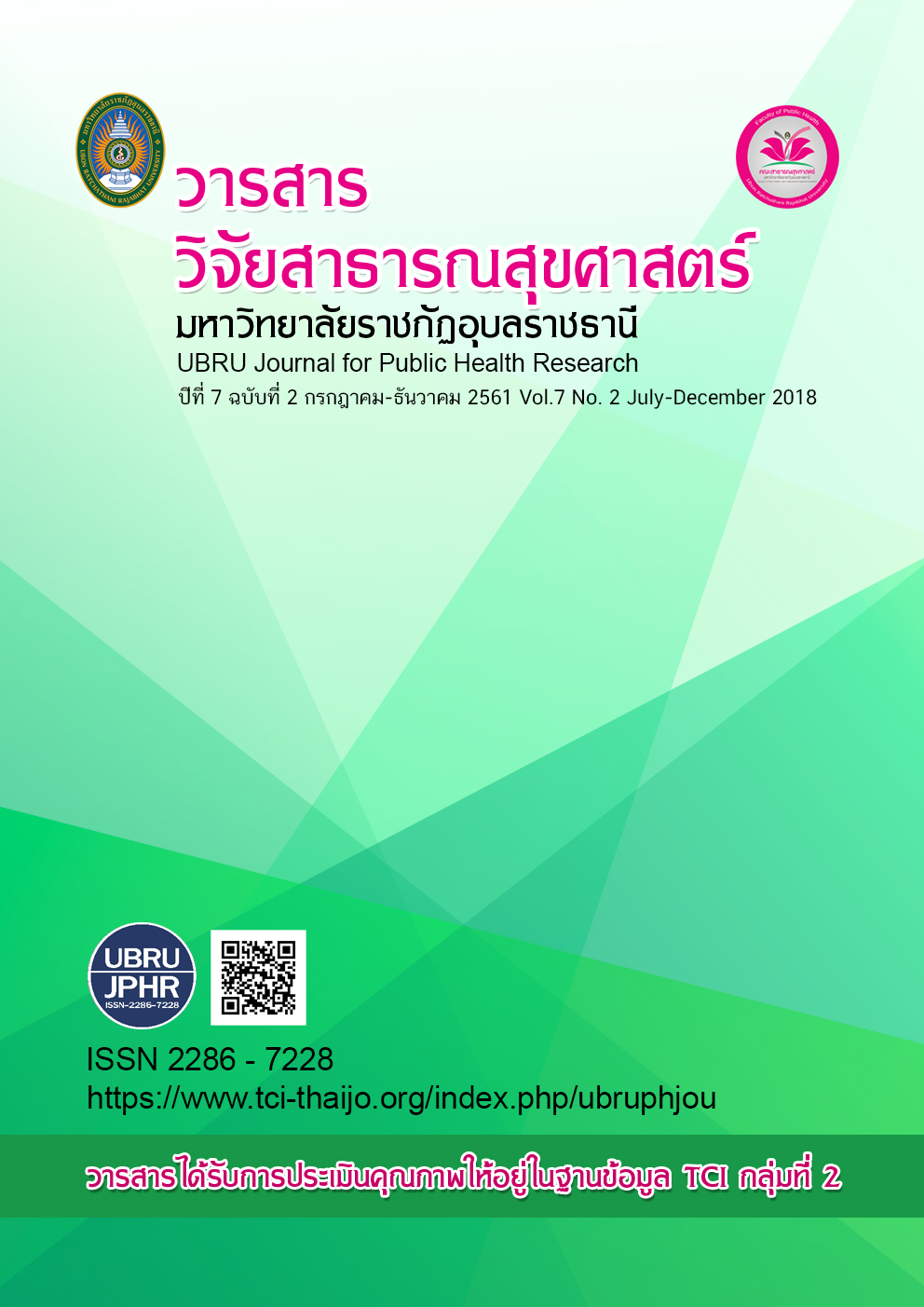Parental behaviors in the use of dry powder antibiotics in newborn to 6 years of age
Keywords:
Parental behaviors, antibiotics, newbornAbstract
This cross-sectional study investigated the parental behaviors of children in newborn to 6 years of age in the use of dry-type antibiotics, those who came to the hospital at the Crown Prince Sawang Dandin Hospital Sakon Nakhon, and factors related to antibiotic use. In February-June 2017, a simple sampling of 65 of the 219 samples, data was performed using descriptive statistics and inferential statistics. The results showed that most of them were female (71.9%), aged from 15 to 88 years. The most common age was 31-50 years (53.8%). The overall drug use behavior (knowledge, attitude, practice) was at a moderate level. There were a number of low-scoring issues such as Recognize that antibiotics are the same as anti-inflammatory, do not use measuring devices, stop taking medicine when symptoms improve, they think that the injection is better than the drug regardless of the severity of the drug allergy, antibiotics should be given immediately when children got a cold, taking medication for other children with similar symptoms. Age factor was a significant associate with drug use in children (r = 0.385, p-value = 0.003). Conclusion of the findings that need to be improved some knowledge, shift their attitude and the use of dry-type antibiotics in children. In addition, the age-related factors associated with the use It should be further investigated which age group should be recommended. To monitor and emphasize the advice that is more appropriate and appropriate for each case.
References
บุปผา ศิริรัศมี. (2540). พฤติกรรมสุขภาพในเรื่องการใช้ยาปฏิชีวนะของประชาชนในจังหวัดนครปฐม. กรุงเทพฯ: สถาบันวิจัยประชากรและสังคม มหาวิทยาลัยมหิดล.
วสาวี กลิ่นขจร, ศิริรัตน์ กาญจนวชิรกุล. (2554). พฤติกรรมการใช้ยาปฏิชีวนะของผู้รับบริการในโรงพยาบาลส่งเสริมสุขภาพ ศูนย์อนามัยที่ 3. [ออนไลน์]. ได้จาก http://hpc3.anamai.moph.go. [สืบค้นเมื่อ 3 มกราคม 2561]
วิษณุ ธรรมลิขิตกุล. (2555). แผนการดำเนินงานและความคืบหน้าการจัดระบบและการขับเคลื่อนระบบการป้องกันควบคุมและแก้ไขการดื้อยาต้านจุลชีพในประเทศไทย. กรุงเทพฯ: วิจัยระบบสาธารณสุข.
สถาบันสุขภาพเด็กแห่งชาติมหาราชินี. (2556). ลดพึ่งยาปฏิชีวนะ ลดวิกฤติเชื้อดื้อยาในเด็ก. [ออนไลน์]. ได้จากhttp://www.wongkarnpat.com/viewpat.php. [สืบค้นเมื่อ 3 มกราคม 2561]
สุธาสินี ทรัพย์สังข์ และคณะ. (2559). ผลของนวัตกรรมการให้ข้อมูลร่วมกับการใช้ฉลากช่วยยาปฏิชีวนะชนิดผงแห้งต่อความเข้าใจของผู้ปกครองในกลุ่มผู้ป่วยเด็กโรคติดเชื้อทางเดินหายใจส่วนบน โรงพยาบาลกงไกรลาศ อำเภอกงไกรลาศ จังหวัดสุโขทัย. ปริญญานิพนธ์สาธารณสุขศาสตรบัณฑิต มหาวิทยาลัยนเรศวร.
วราวุธ จวงจันทร์. ความรู้ ทัศนคติและการปฏิบัติตัวในการใช้ยาปฏิชีวนะ ในโรคระบบทางเดินหายใจส่วนบน โรคท้องร่วงและแผลเลือดออกของคนวัยทำงาน ณ โรงพยาบาลส่งเสริมสุขภาพตำบลอำเภอกันตัง จังหวัดตรัง. โครงการเครือข่ายห้องสมุดแห่งประเทศไทย. [ออนไลน์]. ได้จาก https://drive.google.com/drive/folders/1zCHxXhJyizhOODqJ3GESZooy7-zXZGbK. [สืบค้นเมื่อ 3 มกราคม 2561]
Downloads
Published
How to Cite
Issue
Section
License
เนื้อหาและข้อมูลในบทความที่ลงตีพิมพ์ในวารสารวารสารวิจัยสาธารณสุขศาสตร์ มหาวิทยาลัยราชภัฏอุบลราชธานี ถือเป็นข้อคิดเห็นและความรับผิดชอบของผู้เขียนบทความโดยตรงซึ่งกองบรรณาธิการวารสาร ไม่จำเป็นต้องเห็นด้วย หรือร่วมรับผิดชอบใดๆ
บทความ ข้อมูล เนื้อหา รูปภาพ ฯลฯ ที่ได้รับการตีพิมพ์ในวารสารนี้ ถือเป็นลิขสิทธิ์ของวารสารฯ หากบุคคลหรือหน่วยงานใดต้องการนำทั้งหมดหรือส่วนหนึ่งส่วนใดไปเผยแพร่ต่อหรือเพื่อกระทำการใดๆ จะต้องได้รับอนุญาตเป็นลายลักอักษรณ์จากบรรณาธิการวารสารนี้ก่อนเท่านั้น


